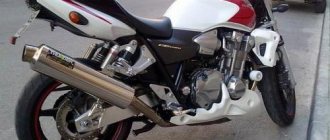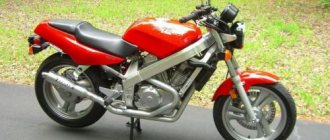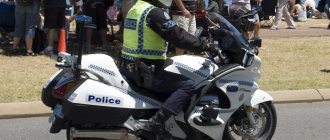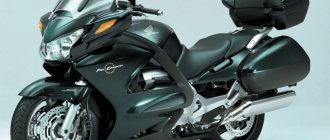Honda ST1100 Pan-European
I bought a motorcycle in November 2013. Since the beginning of the season I have ridden 4000 km, so I can share some of my feelings about the motorcycle.
I chose the motorcycle almost at random, since I can’t say that I’m particularly good at the technical part. But it seems like I found a normal specimen: nothing snotty anywhere, no leaks, no knocks, no buzzing. Works smoothly. The rear tires are new, the front tires are about 5-10% worn. The plastic is not cracked, there are no large scratches, and there are few small ones, which, considering the year (1998), is quite tolerable. Of the minuses, we can only note a small coating of rust on the frame, which, again, taking into account the age, is quite understandable, and I had no illusions about this when choosing a motorcycle. Moreover, it was (supposedly) brought from England (as they said in the motorcycle showroom), although the country of import is Belarus in the title.
So. The motorcycle seemed very heavy in the first days. The motorcycle is NOT for people of short stature, but even those taller than 190 will be uncomfortable, my height is 190 and I sit almost resting my feet on the plastic. It started without problems even in the garage in winter, and even more so now. After two days of rolling in, the weight of the motorcycle practically ceased to be felt. The pan is quite easy to operate. Acceleration is not explosive, of course, but neither in the city nor on the highway has there been a case so far that I did not have enough acceleration. I accelerated to 210, up to 200 it accelerates briskly, after that it barely accelerates. By the way, the wind protection is simply excellent; you can go 180 degrees without bending down, without experiencing any discomfort. The side wind never really bothers you, and the gusts from the trucks don’t blow you away. The brakes are disgusting, just quiet horror)) I read that the brakes on the pan are back to back, but they are back to back up to a speed of 120-130, after which their effectiveness is sorely lacking. By the way, I keep the cruiser at 150-160. On the highway, cruise control is extremely lacking, I think I’ll bother with this issue later.
The second number seems to be comfortable, at least after 200 km without stopping, no one really complained. By the way, consumption on the highway in the mode 140-150 is 6.5 liters, 180-200 is 8.7 liters, in the city it’s 6.8 liters. The motorcycle has two convenient removable suitcases and one central top case (also removable), but it doesn’t look right without them). Among the modifications on my motorcycle, additional side shields, shields on the mirrors, and emergency lights were made (all of which were not made by me). Of my modifications, only the cigarette lighter). On the road, you need to constantly monitor the pressure in the wheels. I read about it, but ended up falling for it myself. During a sharp start through the garden, the front wheel unloaded, and then all its weight fell perpendicular to the track (i.e., into a bump), and I caught a wobble. It was not very pleasant, since at this moment the steering wheel begins to wobble strongly from lock to lock and all 320 kg of the motorcycle’s mass begins to be felt on it.
In general, I liked the motorcycle.
It is perfect for the purpose that I purchased it for - long-distance driving. He goes along the track very confidently and quickly. By the way, in traffic jams you don’t experience much discomfort on it, since the moto is quite narrow, its widest part is the mirrors, which are always in front of your eyes, and when they hit the car mirrors, they snap off and hang on the safety belt. In general, here’s a short review, I don’t know what else to write, it’s kind of a mess in my head)) In general, if I remember anything else, I’ll write.
Recall of the Honda ST1100 Pan European motorcycle
I owned Pan for a short time, a little less than three years. But he left a lot of impressions! And 99% are positive! In three seasons, I covered a little more than 90,000 km on it. Mainly long rangers. Home is work, in the city it’s the same, but without fanaticism. I don’t like the city crowd... Honda ST1100 is a 100% touring motorcycle! With all the consequences. Landing. Wind protection. Equipment. Everything about him suggests that his element and home are long straight lines to the horizon with good! asphalt surface. Only on the track can you realize its full potential and understand what a touring motorcycle should be like. But first things first.
Appearance. By modern standards it is certainly outdated. And some will find it unattractive, and may even discourage them from purchasing. But I want to say that behind such a nondescript and simple “face”, there is hidden the most thoughtful ease of maintenance, ergonomics and reliability. Nothing superfluous and everything in its place.
Ergonomics. The fit on it is classic. Almost vertical. With a slight forward bend. With excellent wind protection. When it rains, you drive absolutely dry and clean. It doesn’t blow anywhere and doesn’t flood. So does the passenger. But I recommend installing deflectors on the mirrors and on the sidewalls. With them the level of comfort is even higher! The control buttons on the remotes are in the usual places and will not reveal anything new for the owner. But personally, in place of the right remote control, I installed the switch control unit from the police version. With a safe engine shutdown and additional buttons to which I connected the fog lights and motorcycle lights. Such a control unit can be bought on English eBay. It's inexpensive. But the connection took me almost half a day, since I had to resolder the contacts and shorten the wiring a little. You can see in the photo below... The saddle has no adjustments. Wide. Soft and comfortable enough for both the pilot and the passenger. The instruments are located high and you don’t have to lower your head to read their readings. They just sparkle in the sun. During the day, if the sunlight falls from behind, then practically nothing is visible. I also recommend changing the backlight bulbs to LEDs with five diodes. The mirrors are located at waist level and will take some getting used to at first. They are adjustable over a very wide range and allow you to clearly see the situation behind you. BUT! The mirrors are attached to the body with three iron latching pins and when hitting a good bump they more than fly off onto the asphalt, cracking and scratching. Therefore, I recommend tying the mirrors to the eyelets under them with a regular underwear elastic band. Then, if they fly away, they will hang on these elastic bands and will not fall anywhere. I don't recommend plastic ties. I also tied them, even thick ones, but they tore. The light from the headlight, even if there are two bulbs there, is not enough. I installed more powerful lamps. Did not help. Only installing bi-xenon and fog lights saved it. There was a lot of light and the road was clearly visible at night. It has enough space for installing ignition units under the “face”. The original side cases are not that large in volume, so you can’t do without a central case when traveling. Also, the side cases do not have the most reliable fastening, although they are closed from below with a clasp lock. I had a couple of times when the lock opened on a bump and the trunks flew away... Naturally they broke and cracked. Therefore, I recommend tying the panniers by the handles to the rear passenger handrails with leather straps. This is quite aesthetically pleasing and even if the lock opens, the case will remain in place, since the leather is elastic and will not tear, as if it were tied with a plastic tie, for example. By the way, I never removed the panniers. In traffic jams, if the face of a motorcycle passes through the mirrors, then the rear will also pass. Mirrors are a kind of indicator of the width of the motorcycle. Well, the biggest plus of this motorcycle is the tank! 29 liters! That, with a moderate average consumption of 6 liters, is enough for almost 500 km!
Engine and transmission. “V”-shaped with four cylinders! The motor is simply fantastic! With soft work. No vibrations. With a pleasant rustling sound. During the entire period of use, nothing broke in it. Scheduled maintenance only. I read on the English forum of EuroPanov owners that Honda ST1100 engines run 300-400,000 km without any serious interventions. One of the most reliable motorcycle engines! The engine has almost car-like traction from the bottom up to the red zone. He has no cutoff. Anyone can use gasoline. I refueled both AI-80 and AI-98. No difference. I mostly drove the AI-95. In the city you can drive in third gear, like an automatic transmission. From 20km/h to 180km/h. It pulls great. The engine has a timing belt drive, the service life of which is about 90,000 km. The clutch is multi-plate and in an oil bath. Very soft and clear. The most interesting thing is that it is located in front of the engine and has a gear drive to the gearbox. To replace the discs, you need to remove the lower skirt and unscrew the clutch housing cover. Everything is very simple and well thought out. In general, in terms of maintenance, the Honda ST1100 is made very simply and affordable. The gearbox is very soft and clear. Shifts are smooth and always in the right place. But at very high speeds, second and third gears may not engage, so I don’t recommend cranking the engine in lower gears. The mileage on my motorcycle was almost 200,000 km, but it did not consume oil. I didn’t add any more. From replacement to replacement (10,000 km), the level always remained level. The cardan drive only increases the degree of reliability and unpretentiousness. Every time at the beginning of the season I filled in 150g of oil and no problems. I didn’t even think about him, and he didn’t remind me of himself. As a rule, all motorcycle stores for the Honda ST1100 have all filters and pads in stock. But some consumables will have to be ordered.
Frame and suspension. The duplex frame speaks for itself that the stability of the motorcycle in long turns, especially with bumps, is not the best. The motorcycle begins to wobble, which can lead to wobbling. Therefore, the speed in a turn must be selected according to the quality of the asphalt. In addition, it has to be laid by force. In a straight line it goes very smoothly and smoothly, like a locomotive. Swallowing bumps and swaying a little, like an American Lincoln of the 80s. In general, the suspension of the 1100th Pan is weak. The front fork “walks” at low speed and seems to twist and break when turning/turning. Despite the fact that it was properly maintained. The heavy weight of the motorcycle and the thin 39mm front fork stays have an effect. Installing a third traverse may make this moment a little easier, but not by much. After riding a motorcycle with this addition, I realized that there was no point in installing it. The rear shock absorber is also archaic and simple. If you drive together, loaded with camping gear, the suspension gets hit very hard, even with the shock absorber tightened up. Sparks are generated from the center stand. The rear swingarm must be periodically inspected for rust (bottom) and bearing play. This is the weak point of this motorcycle.
Brakes. On mine there were the simplest ones without ABS and not combined ones. Frankly speaking, I missed them. After a couple of extreme braking they overheat and become “wobbly”. For such a heavy motorcycle, with such speed capabilities, this is a huge minus! Therefore, I recommend buying a motorcycle with a combined brake system and ABS. There they are much more informative and more tenacious with less effort on the lever. Pads are always available in motorcycle stores, both original and non-original.
Electrical equipment. On motorcycles before 1997, the generator has a power of 20A. Which is very little. You can install a heated steering wheel and a couple of PTFs... but nothing more. Since 1997, generators began to be installed at 40A, which greatly simplifies the operation of the motorcycle and the ability to connect additional electrical equipment. But despite everything, 20-amp generators are also very reliable and there are very few cases of their breakdowns. Replacing all incandescent light bulbs with diode ones, plus installing xenon in the headlight, will significantly lighten the load and give a couple of extra “free” watts for charging the phone, which I placed in the left side compartment near the false tank. Installing a 40-amp generator instead of a 20A is possible, but you will have to make an adapter because there are slight differences in the mounting locations. Details about such operations are written on the English forum of Honda ST1100 .
ST1100 is a vehicle for long-distance travel on good roads. Its main trump cards: wind protection, traction and long service intervals.
Weight. The motorcycle initially gives the impression of being heavier than it actually is. This is due to the high center of gravity. At first, this really depressed me, especially after the Yamaha Super Tenere. But then I realized that disadvantages are the other side of advantages. After all, this is one of its tourist advantages. I would be very upset if I were blown into oncoming traffic by the wind from an overtaking truck, as can easily happen on lighter motorcycles. Moreover, you get used to the peculiarities of maneuvering on such heavy equipment and stop noticing. Subsequently, when switching to lighter motorcycles for business, you get great pleasure from their lightness and nimbleness. But Panochka remains such a nimble limousine. The motorcycle is comfortable on a long journey.
Plastic. Wind protection. Wind protection provides excellent protection from dirt and wind. To provide even better protection, I recommend installing deflectors on the rear-view mirrors and extensions on the side plastic (the so-called “aero package”). These accessories can be ordered from the standard OEM parts catalog for model years 1998-2002. You can even come up with shields to protect boots from splashes; on American forums there were craftsmen who sawed out similar structures from polycarbonate.
Dimensions. The motorcycle is wide. The rear-view mirrors are mounted at the same height as on cars, so you won't see too much in traffic jams. But the width of these mirrors is slightly narrower than the rear panniers, so that the “overall width indicator” is always before your eyes. It’s convenient to look in the mirror, you can see a lot of what you need, your hands don’t get in the way. They are attached to three ball-latch fasteners and are additionally connected to the bracket with a short plastic strap. This comes in very handy when you hit someone with the mirror and it falls off, hanging on the sling. Mirrors are adjusted manually by pressing on the mirror. The mirror casing that fell off from the impact is attached back after precise aiming and a light blow.
Engine. Powerful motor with very good torque. It goes both “from below” and “from above”. Of course, you won’t get a superbike kick in the ass at 8000 like you do with a Ninja-cut engine, but overtaking on a long climb on a fully loaded motorcycle is easy. In general, the engine of this motorcycle is a separate work of engineering. The camshafts are driven by a toothed belt, the longitudinal arrangement of the V-shaped four-cylinder engine, which allows the use of rear wheel drive by a cardan shaft, ease of access to service points, and long service intervals provide a lot of pleasant sensations during operation. This engine is even made in the automobile, and not the motorcycle, division of the HONDA , as evidenced by the emblem on the oil filler cap. Thanks to this, some sensors and other small things (like the cover itself, for example) are unified with the Honda Civic/Accord 1994. The engine is large, heavy and hot. In the summer, the fan drives air through the radiator and it comes out of all the cracks directly at the driver. Therefore, in the heat in city traffic jams, you will fry, evaporate or dry out (depending on your build). It is a pity that such a useful phenomenon disappears when driving along the highway on a long journey, since the temperature regime stabilizes at speed. The motorcycle has a large, almost automobile-sized oil system. The engine is reliable, I have not seen any complaints about the engine either from mechanics or on Western forums. Personally, on my motorcycle, the rings on the right rear cylinder became coked, which was overcome by a specialized liquid. However, this malfunction seems to me to be quite typical for older motorcycles. The fact is that the right rear cylinder is the highest and hottest point of the engine. I assume that the oil that remained on the rings when the motorcycle was stored thickened and formed a fireproof sediment. I recommend that future owners take an interest in the condition of the 3rd cylinder.
Frame. The frame is steel, duplex, very strong. Compared to modern diagonal aluminum structures, the frame has insufficient torsional rigidity, but can be repaired in the field, which makes this motorcycle much more suitable for traveling around Russia. Comfortable cruising speed on the ST1100 is 160-180 km/h. If you start to accelerate, the motorcycle begins to yaw and the fuel decreases before your eyes. So whatever you gain on that particular leg is lost when you refuel. To make your motorcycle more stable in corners, keep the tires as new as possible and the fork oil as hard as possible. Be sure to monitor the condition of the wheel bearings and steering column; the large mass of the motorcycle causes them to fail relatively quickly, especially on uneven roads.
About the fork. On the first generation ST1100, the fork had a 41mm diameter of stays, which is not enough for active riding at high speed. Taking into account the quality of SuperBtace versions with ABS/TCS/CBS, the feathers became 2 mm thicker, it became better. But by today's standards, it's still not enough. Taking into account the quality of our roads, it is recommended to replace guide bushings every 10 thousand km, that is, almost once a season. After modernization in 1996, they began installing feathers with a diameter of 43 mm on the version with ABS, and it became much better. For the rest, there are two options left: either install a fork from a Honda CBR1100XX , or don’t drive too hard. To reduce the bends of the fork on older models, Western craftsmen came up with an additional stainless steel jumper, which prevents the forks from moving apart when braking in different directions under heavy loads. The name of this part is Super Brace. Those who use it praise it very much, saying that the contrast is striking.
And one last thing about the frame and fork. To avoid the impression that the frame, pendulum and fork are horribly flimsy, I will say that the rigidity is quite sufficient for a quiet touring ride. If you become boring and literal, then there is a difference. And so, for ordinary people like me, there is enough of everything, even more than enough. And certainly better than the Honda GL1500 .
On-board network. On versions before 1995, a 28-amp generator is installed, which is enough to supply standard consumers plus a couple of accessories. Additional headlights for such power gradually destroy the generator. After 1995, they started installing a 40-amp one, and things got much better. Installing a more powerful generator is the main point of useful tuning for the Honda ST1100 .
Brakes. The brakes are rather weak for such a mass, remember this on a long journey. I recommend using original brake pads. With them, braking efficiency is much higher. A special word about ABS. The system exists in two versions: ABS (before 1995) and ABS-II (after 1995). Until 1995, two modulators were installed (one for each braking circuit). After 1995, the modulator became one with two circuits and a combined braking circuit was added. In the same form, it migrated to the Honda CBR1100XX . That's the whole difference.
CBS. In general, the system is useful, especially for beginners. But it has one drawback: the rear disc wears out too much. In fact, all used CBS version motorcycles require replacement of the rear brake disc either immediately or in the very near future. Wheels. Rare tire size: rear 160/70R17, front: 110/80R18. The front wheel has a fairly large diameter, which makes driving over uneven surfaces smoother. But in this dimension there is almost no choice of tread types, only touring and highway. I don’t recommend installing wheels with a different profile, because the handling changes dramatically and it is unknown in what modes this will become dangerous.
TCS scheme. Traction Control System (TCS) prevents the rear wheel from slipping when driving on slippery surfaces. Uses the same sensors as ABS. A very convenient and useful system, I tell you. Especially when turning in the rain when hitting the markings. Or when trying to leave a dirty roadside, which you drove onto unknowingly. If you have a choice of which motorcycle to take - with ABS/TCS or not, definitely take it with ABS/TCS.
Cases. The volume of the suitcases is large, which is convenient. Enough to carry a change of clothes and shoes with you, constantly carry a raincoat and shoe covers for motorcycle boots, as well as a warm lining for a jacket. The cases are locked with a key and can be removed. A topcase is not required, but it is simply more convenient to use for storing frequently used items. I have no idea why a tank bag might be needed. If only for a dog.
My opinion: The Honda ST1100 is a good mid-size tourer with a classic design, a reliable engine and well-balanced performance. This motorcycle was used by a large number of intelligence agencies in Europe and was produced until 2007 (in the police version). Moreover, if you look at the statistics of used equipment offers, it becomes clear that the new Honda ST1300 has not been able to repeat the success of the previous model. There are many such motorcycles on offer and they are much easier to find than a Honda ST1100 in good condition.
However, when buying an old Panochka, you need to clearly understand that you will not have a third dimension when riding it. Just right-left-forward-a little back. Not all roadsides will submit to you; there will be those to which you will submit. It used to be very expensive, but today, when the new model reigns abroad, the previous version is slowly being poured into Russia. In the city it is not very comfortable to ride (however, it is a matter of skill), so this motorcycle is used by those people who travel far, but rarely and in gentle modes. So the mileage of 100,000 km and the dense year of manufacture do not mean anything. Much more important is the good overall condition of the motorcycle.
Go to the Honda ST1100 Pan European
Check out the test drives:
- Review and test drive of Honda ST1100 Pan European from the owner
- Test drive Honda ST1100 Pan European from Motorreview
- Test drive Honda ST1100 Pan European from Motorreview
- Test drive Honda ST1100 Pan European from Motorreview
- Test drive Honda ST1100 Pan European from Motorreview
- Test drive Honda ST1100 Pan European from Motorreview








